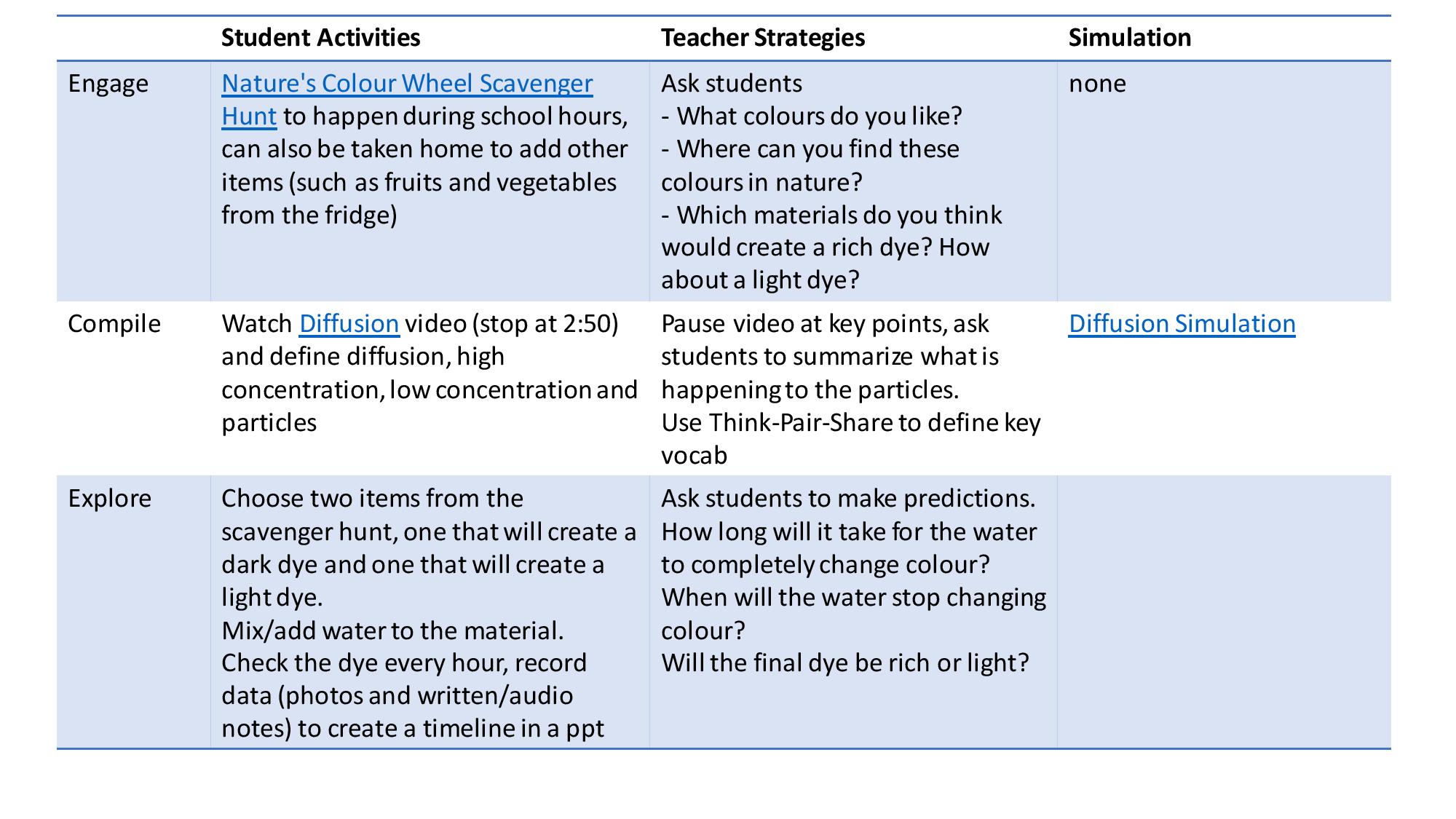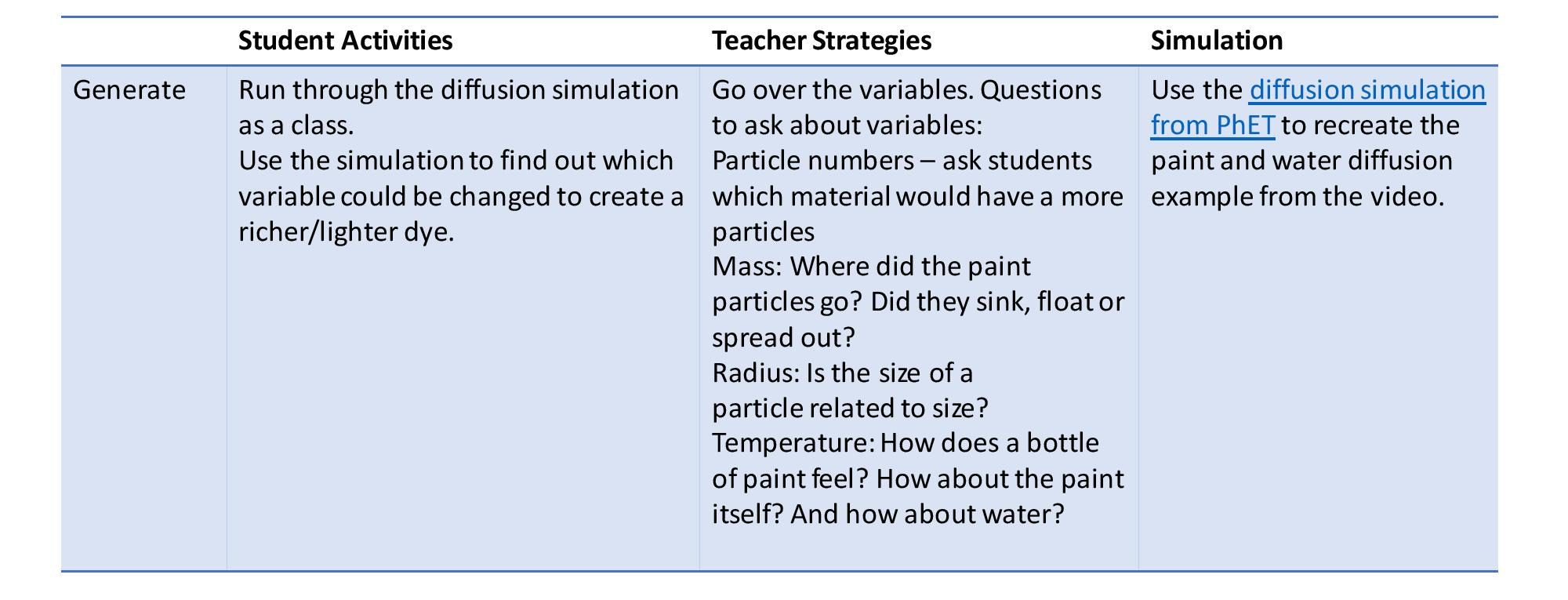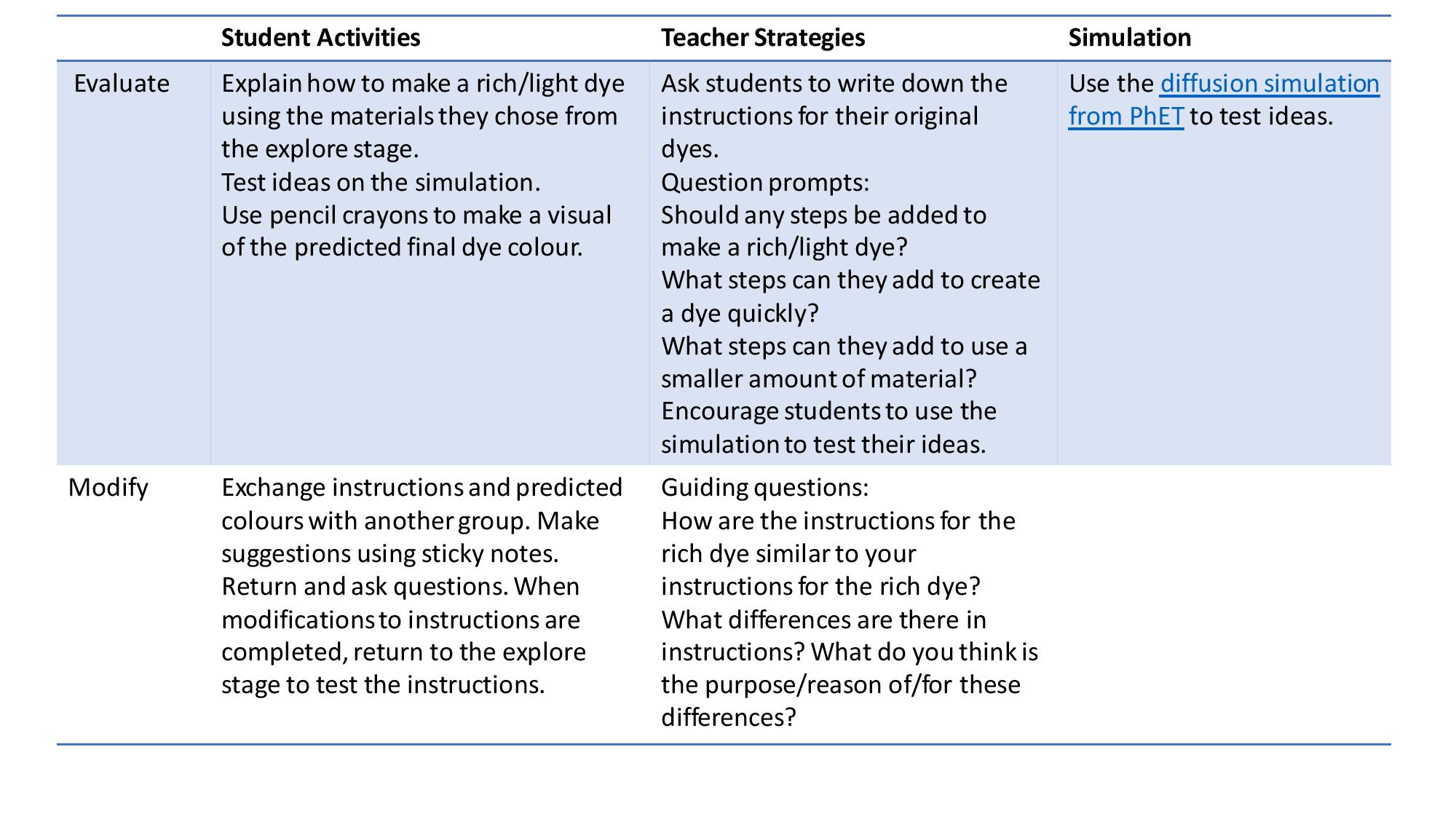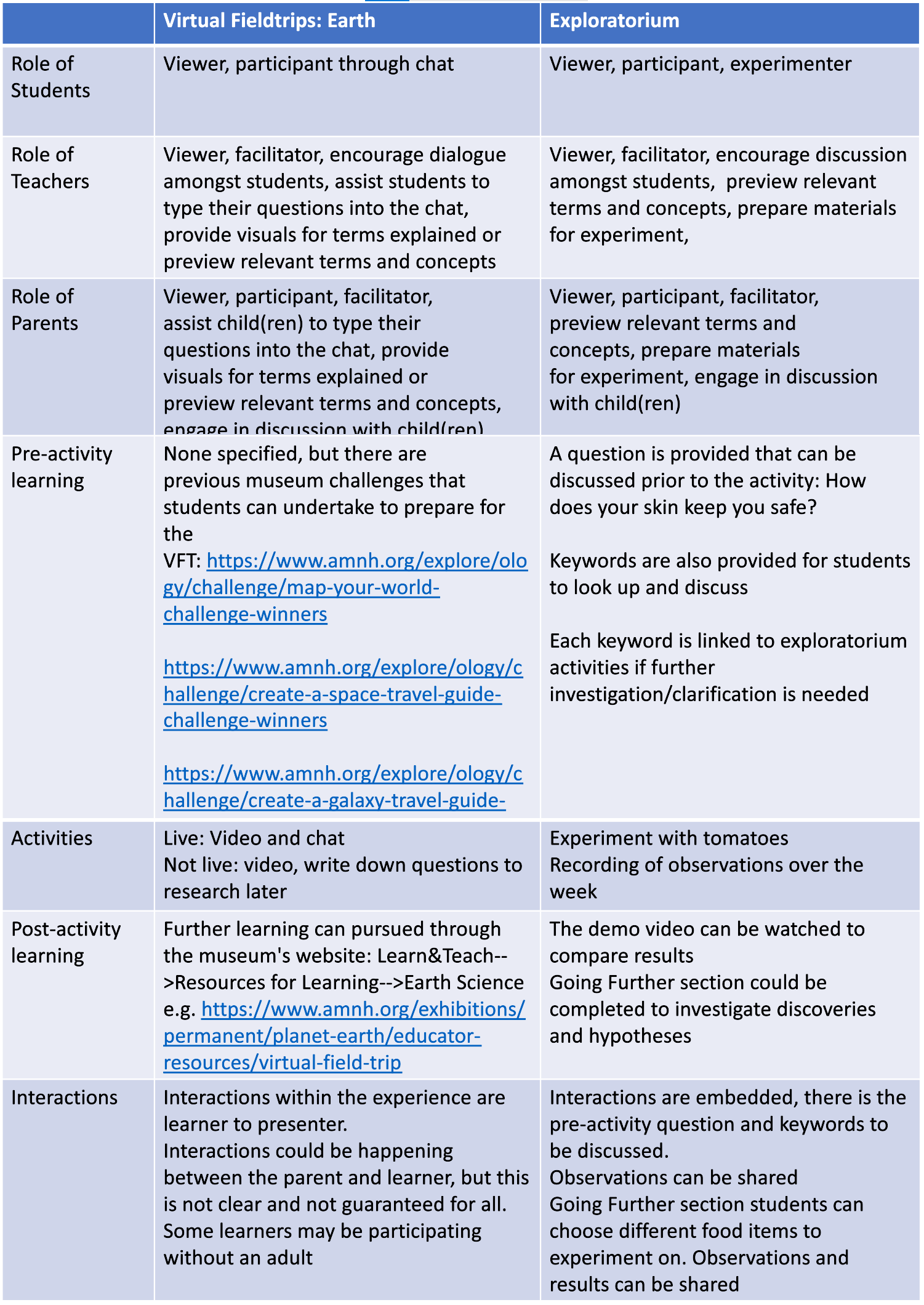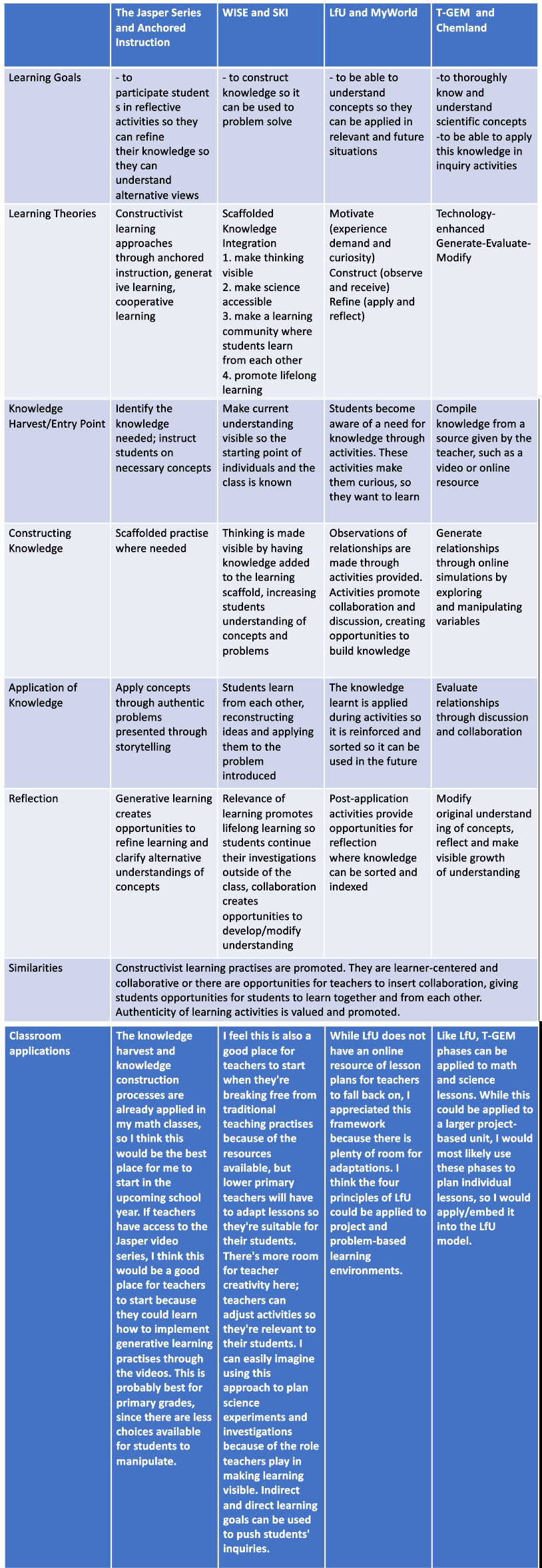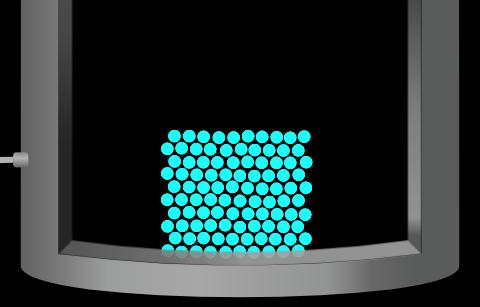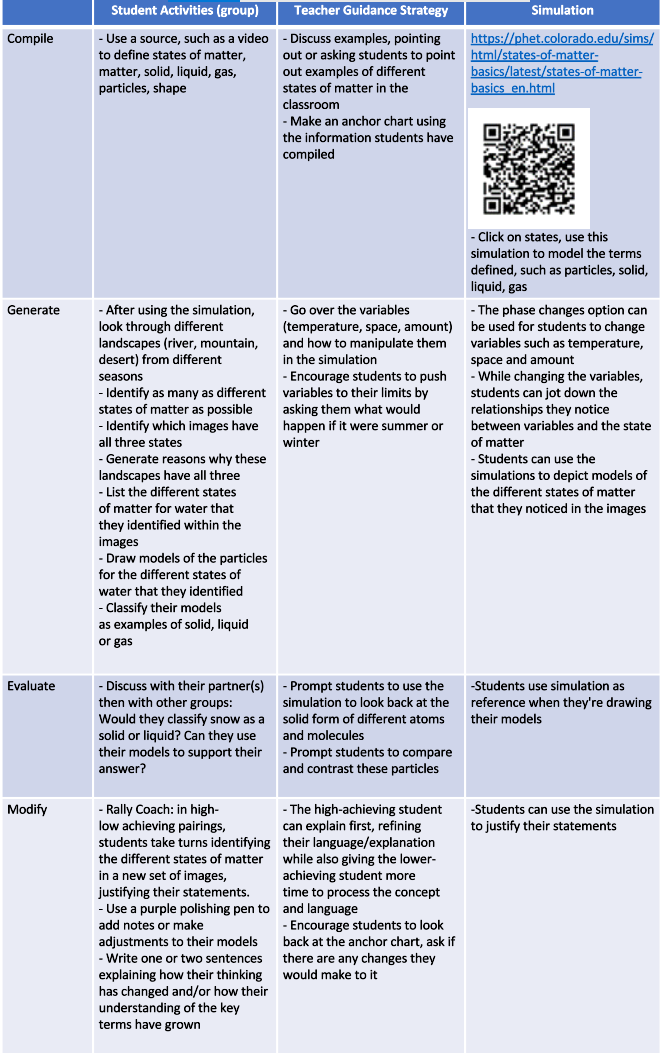My ETEC 533 journey has been similar to climbing a mountain. The further along I’ve made it through the modules, the higher I’ve gotten on the mountain. The higher I am, the clearer the view I have of the tributary rivers (technology, pedagogy and content) and how they intersect and collect to form larger streams and pools of knowledge. There were times when visibility was hazy due to the clouds, but using the knowledge of others and online sources I was able to determine which times the winds would come to clear the clouds, which is similar to how the discussion posts worked. I received valuable feedback and insight from my classmates. I couldn’t have made it as far as I did these last thirteen weeks without them.

The following themes emerged in my e-folio entries: role of technology, visualization of phenomena and cross-curricular planning.
Role of Technology
In Module A, I prized my ability to plan creative, “hands-on” learning experiences. Digital experiences were viewed as
a) a way to increase engagement,
b) a replacement for those times when real experiences were not possible.
When I defined technology in Module A, Jonassen’s (2000) analogy that technology is a tool that carpenters wield to manifest their vision was the definition that resonated the most with me. To use technology the user’s knowledge, efforts and creativity must be combined. I considered what knowledge I was bringing into the process and how my efforts would be applied along with how much time I would put into my efforts. I chose to focus on engagement with a previously used tool, blooket.com. I feel my post lacked creativity because I did not push any boundaries surrounding technology use. Blooket.com could make mental math drills more fun for students, but it is not a tool akin to a carpenter’s tool.
In Module B, a study by Finklestein et al. (2005) found that “properly designed simulations used in the right contexts can be more effective educational tools than real laboratory equipment, both in developing student facility with real equipment and at fostering student conceptual understanding” (p. 2). Anchored learning appealed to me because it was familiar, it reminded me of the immersive storytelling approach I’ve used to teach phonics, but my understanding of technology and its potential remained untapped because I was still viewing it on a superficial level, just a tool to increase engagement and participation–maths drills has been a part of math classes for generations, gamifying it was also something that teachers had implemented through charts and stickers long before blooket.com existed. My post on WISE and SKI was a turning point. At the end of the post, I wrote, “I would integrate technology into the unit as a means to record the plants’ growth through line graphs using excel to record growth, water given and temperature” again, technology was used to replace the traditional notebook and pencil and it was tagged on as an afterthought to fit the requirements of the course. My primary focus was to adjust the lesson context to one my students would find relevant rather than using technology to augment the learning. To give my students such a narrow view of science is a disservice. Even if they do not know or care about a topic, the topic will still affect them, so it is my job to augment a lesson and concept so they can understand both how it works and its significance on their lives. Despite all of this, I greatly benefited from reading other people’s posts and seeing how they incorporated technology into their lesson.
Visualization of Phenomena
The role of technology in my lesson planning was gradually being whittled and transformed into an augmentation tool. The T-GEM cycle prioritizes understanding relationships and their effects on each other (Khan, 2010). Computer simulations are used to enhance the learning process by assisting students to visualize scientific phenomena and the processes behind them (Khan, 2010). I feel this is the activity where I first became a carpenter purposely using her tools. Explaining my vision was still shaky and developing. The feedback I received was mixed. Some people like Wynn (2022) felt that the simulation was too simple, “I found it quite boring that it was only a few metals and waters with no really manipulation of these objects in their respective states. Do you think more objects such as maybe food or liquid items that could be manipulated (maybe poured or thrown or a fan maybe?) would help with student understanding of these concepts?” and Justin (2022) felt that the simulation was too advanced for my students, “[i]t seems very advanced for grade 3.. the relationship between pressure and temperature, the use of kelvin, and the fluid nature of the molecular change introduces a level of complexity that seems like it would confound, rather than help, students that age”. Ironically, when I shifted my focus from engagement to conceptual understandings, I received the most queries about how engaging students would find the simulation. In response to comments that it was too simple, I stated that the simulation was chosen to support students’ abilities to visualize the particle structure of different materials in different states without overwhelming them. In response to comments that it was too difficult for 8-year olds, I noted the importance of the teacher: “While this simulation introduces variables that can be confusing, I think with teacher guidance and direction, students can focus on the key learning points of the lesson”. Besides these comments, I was asked about what questions I would use to guide and challenge my students’ focus. From these exchanges, I realized that while I was better at utilizing technology, I was not utilizing my own knowledge and experiences. The carpenter’s tools won’t move if the carpenter doesn’t hold and direct them.
Simulation link: https://phet.colorado.edu/sims/html/states-of-matter/latest/states-of-matter_en.html

Moving onto Module C, I wanted to continue implementing technology as augmentation tools and improve on my own role in assisting students to visualize scientific and mathematical phenomena. Winn’s (2013) embodied learning connects visuals of phenomena that can be readily seen in everyday life with the hidden processes behind the phenomena. Rogers et al. (2004) highlighted the importance of carefully selecting all augmentation tools and specifying their type, mode and initiator (student, environment or hybrid) to get a big picture of how they would complement each other. Taking the feedback from my T-GEM post and what I learnt from Rogers et al. (2004), I created another T-GEM cycle on diffusion. Teacher strategies were written in more detail, involving questions to support students’ visualization abilities and to better convey my intention to fellow teachers who may read it.
Cross-curricular Planning
During my Module A interview with Ms L, I felt sympathy for her dilemma (and I still do) about giving students enough time to cover the ICT curriculum during the school year. In response to my post, Neill (2022) wondered if Ms L had considered cross-curricular opportunities. This made me wonder why I had not asked her this question myself during the interview. It was then that I realized I was letting “time” become this insurmountable barrier. I did not ask because I felt I understood the answer and the constraints that make cross-curricular lesson planning daunting so well that it was impossible to make significant change.
During Module B, I made it a goal to look for solutions instead of moaning about the restrictions common place to teachers in any situation. Understanding the context as Mishra (2019) pointed out, is crucial for teachers to create change, but fixating on context causes teachers to miss opportunities to provide students with authentic and meaningful learning experiences. I listed units from the most recent school year that I felt were lacking in the depth and robustness that Edelsen (2001) advocates for conceptual understanding. Looking at these units, I looked for cross-curricular opportunities to transform myself into a STEM rather than simply a science teacher and/or math teacher. Using the Learning for Use model, I envisioned a Food Stall Unit which combined mathematics, English and science. Students would create their own businesses, manage budgets, write persuasively and learn about health and nutrition. Then in Module C, I applied the T-GEM cycle to create a science lesson on diffusion to complement an art unit on Australian aboriginal patterns. I feel my shift in thinking allowed me to embed the T-GEM cycle within Edelsen’s (2001) LfU model by connecting ideas from different content areas to give students “deep” and “robust” learning experiences (p. 351) which will benefit the students’ understanding and application of concepts.
Conclusion
In my introductory post to my inquiry e-folio, I noted my tendency to focus on contextual issues of the school system such as time, and my goal to inquire beyond these issues and into TPACK. While I did not delve into TPACK straightaway, my e-folio’s three recurring themes demonstrate the progress I made in furthering my knowledge about TPACK; however, this is still an area in development. I will continue to build on the role of technology and my own role in supporting students’ visualization capabilities by using the tools shared in the modules and comments and finding new tools to explore.
Going over my learning journey this term, I see a preference for T-GEM. To continue making progress, I should revisit the other frameworks from module B and look over my list of units to consider which frameworks could best complement those units. A carpenter can’t forget about the other tools she has and allow them to rust with disuse. I think the next step to taking cross-curricular planning further would be to collaborate with other teachers.
When I think back to my cross-curricular lesson plan on diffusion, it should have been an obvious and logical decision to collaborate with the art teacher, but the idea was never expressed by either of us. Collaboration did not originally happen due to time constraints; the art teacher was using her prep time to teach my students about homemade dyes and although I read her lesson plans for the unit, I was unable to clearly visualize and understand the learning experiences she had planned. This harkens back to Mishra’s (2019) upgraded TPACK diagram where Contextual Knowledge encompasses TPACK and teachers are seen as “intrapreneurs” who not only function as curriculum designers but as makers of “sustainable” change (Mishra, 2019, p. 78). Now that I am entering my second year at my current school, I can use my contextual knowledge to identify areas I can initiate “sustainable” collaboration through sit-down co-planning and/or through asking for feedback on individually completed planning.
Sustainable change brings about new questions. Can sustainable change happen in one or two years? Could this be a goal for myself that changes my pattern of changing schools every 2-3 years? Can I do this if I am not in a leadership position?
To seriously consider the last two questions, I need to continue inquiring into TPACK. How am I arranging and developing my own knowledge to strengthen and adjust my students’ science and mathematics foundations? This is one of the questions I posed at the start of this e-folio. It stemmed from Shulman’s (1986) statement that knowledge is not carved onto a blank slate, it is “reorganizing the understanding of learners” (p. 10). I have been a teacher for over a decade, so my own understanding needs “reogranizing” and as seen from the publication date ranges for the course readings, while older publications can still be relevant, new discoveries in learning are continuously being made and approaches updated.
Perhaps the Mount Everest metaphor can be updated: Just as Mount Everest continues to grow in height, TPACK grows, yet this is not an issue for the carpenter-mountaineer who is up-to-date with the latest technology and approaches, so they can add to the path going upwards with the proper tools.
References
Edelson, D.C. (2001). Learning-for-use: A framework for the design of technology-supported inquiry activities. Journal of Research in Science Teaching, 38(3), 355-385.
Finkelstein, N.D., Perkins, K.K., Adams, W., Kohl, P., & Podolefsky, N. (2005). When learning about the real world is better done virtually: A study of substituting computer simulations for laboratory equipment. Physics Education Research, 1(1), 1-8.
Jonassen, D. H. (2000). Computers as mindtools for schools (2nd Ed). Upper Saddle River, NJ: Merrill/ Prentice Hall.
Justin. (2022, July). Re: Snowflakes and states of matter [discussion post comment]. Retrieved from https://edge.edx.org/courses/course-v1:UBC+ETEC533-66A+2022S1-2/discussion/forum/df01129f145b7c221c05d765ab233b16a6279f22/threads/62d470bfd56b3a04816120fd
Khan, S. (2010). New pedagogies for teaching with computer simulations. Journal of Science Education and Technology, 20(3), 215-232.
Mishra, P. (2019). Considering contextual knowledge: The TPACK diagram gets an upgrade. Journal of Digital Learning in Teacher Education, 35(2), 76-78.
Neill. (2022, June). Re: Interview with ms l [discussion post comment]. Retrieved from https://edge.edx.org/courses/course-v1:UBC+ETEC533-66A+2022S1-2/discussion/forum/22c3bbe3bb78d0b632518e6f0f06acede60b2a08/threads/62a10c41d56b3a0472611ef8
Rogers, Y., Price, S, Fitzpatrick, F., Fleck, R., Smith, H., Randell, D., Muller, H., O’Malley, C., Stanton,D., Thompson, M., & Weal, M. (2004). Ambient Wood: Designing new forms of digital augmentation for learning outdoors. Proceedings of Interaction, Design and Children, Maryland, US, 3-11.
Shulman, L.S. (1986). Those who understand: Knowledge growth in teaching. Educational Researcher, 15(2), 4-14.
Winn, W. (2003). Learning in artificial environments: Embodiment, embeddedness, and dynamic adaptation. Technology, Instruction, Cognition and Learning, 1(1), 87-114.
Wynn, (2022, July). Re: Snowflakes and states of matter [discussion post comment]. Retrieved from https://edge.edx.org/courses/course-v1:UBC+ETEC533-66A+2022S1-2/discussion/forum/df01129f145b7c221c05d765ab233b16a6279f22/threads/62d470bfd56b3a04816120fd
David, L. (2010, October 29). Re: E-ZPass is a life-saver (literally) [Blog comment]. Retrieved from http://freakonomics.com/2010/10/29/e-zpass-is-a-life-saver-literally/#comment-109178

